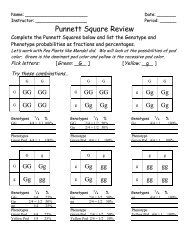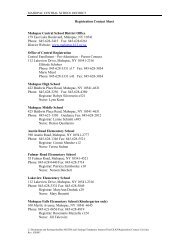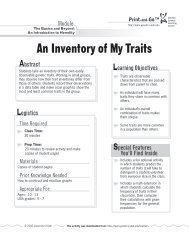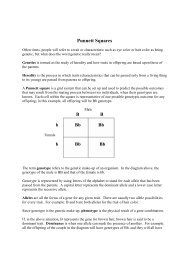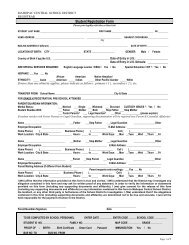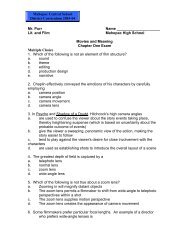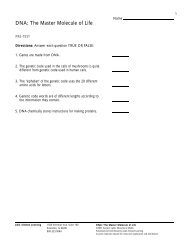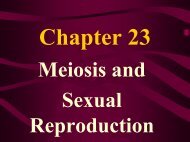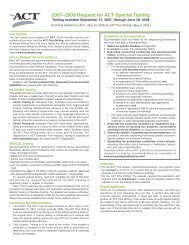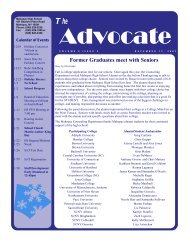Chapter 28
Chapter 28
Chapter 28
You also want an ePaper? Increase the reach of your titles
YUMPU automatically turns print PDFs into web optimized ePapers that Google loves.
<strong>Chapter</strong> <strong>28</strong>ModernMendelianGenetics
(I) Gene-Chromosome Theory• Genes exist in a linearfashion onchromosomes• Two genes associatedwith a specificcharacteristic areknown as alleles andare located onhomologouschromosomes
Gene Linkage• Genes for different traits are locatedon the same chromosome pair, andare said to be linked• Therefore they are usually inheritedtogether
Crossing-Over• The chromatids of homologous chromosomesoften twist around each other, break, exchangesegments and rejoin. Crossing-over is a source ofgenetic variation in sexual reproduction
(II) Sex-Linked Traits1. Each human cell contains 46 chromosomes22 pairs of autosomes1 pair of sex chromosomesa) sex chromosomes are designated as“X” and “Y”XX= femaleXY= male
2. The sex of a human is geneticallydetermined at fertilization whena sperm cell containing eitherthe X or Y chromosome uniteswith an egg cell containingthe X chromosome
3. Sex-Linkagea) Morgan’s work with Drosophila demonstrated thatgenes for certain traits are located on the X chromosomeand do not appear on the Y chromosomeb) genes found on the X chromosome are said to besex-linked genesc) recessive traits that are sex-linked occur morefrequently in males than in females. For the recessivetrait to show in a female, she must be homozygousrecessive. The gene must be present on both of her Xchromosomes ( X` X`)d) for the recessive trait to show in males, the recessivegene on the X chromosome will be expressed since itdoes not appear on the Y chromosome ( X`Y)
Human Disorders associated withSex-Linked Genes1. Hemophilia- disease in which the blood doesnot clot properly2. Colorblindness- inability to see certain colors,most commonly red and green* Both of these disorders are more common inmales than in females because a female willnot show the disorder as long as she has onenormal gene. Females who are heterozygousfor a sex-linked trait are said to be carriersfor that trait
Sex-Linked TraitsX HX hX H X H X H X H X HYX H YX h YHow many offspring have hemophilia?
Sex-Linked TraitsX HX hX H X H X H X H X HYX H YX h YHow many offspring have hemophilia? 1
Sex-Linked TraitsX HX hX h X H X h X h X hYX H YX h YHow many offspring have hemophilia?How many offspring are carriers?
Sex-Linked TraitsX HX hX h X H X h X h X hYX H YX h YHow many offspring have hemophilia?How many offspring are carriers?
Human Pedigree
(III) Mutations• Changes in genetic material are called mutations• If a mutation occurs in the sex cell, it may betransmitted to the offspring• Mutations occurring in body cells may be passedon to new cells of the individual due to mitosis,but will not be transmitted to the offspring bysexual reproductionEx: cancer• Mutations can be classified as chromosomalalterations or gene mutations
Chromosomal Alterations• Is a change in the number ofchromosomes or in the structure of thechromosome• The effects of chromosomal alteration areoften visible in the phenotype of anorganism because many genes are usuallyinvolved• An example of chromosomal alteration isnondisjunction
Nondisjunction• One or more pairs ofhomologous chromosomesfail to separate.• This results in gameteswith more (or less) thantheir normal haploidchromosome number
If these gametes are involved in fertilization, theresulting zygote may have more (or less) than thenormal diploid chromosome numberExamples:1. Down’s Syndrome- results from the possessionof an extra chromosome. This is due to thenondisjunction of chromosome #21 in one of theparents. Will result in mental retardation orphysical abnormalities
2. Polyploidy- sometimes all 22 chromosomal pairsfail to separate. The resulting 2n gamete fuseswith the normal n gamete, producing a 3n zygote.This is common in plants but rare in humans
Gene Mutations• Involves a random change in thechemical nature of the geneticmaterial (DNA)• Some gene mutations, like albinismare obvious, while others are notnoticeable
A woman with Abinism
Mutations
Mutations
Mutations
Polydactyl mutation
(IV) Mutagenic Agents• Causes mutations1. Radiation- ultraviolet light, x-rays,radioactive substances2. Chemicals- asbestos fibers
(V) Human Genetic Disorders
1. Phenylketonuria (PKU)• A disorder in which the bodycannot synthesize an enzymenecessary for the normalmetabolism of phenylalanine• Results in mental retardation
2. Sickle-cell Anemia• A gene mutation that results in theproduction of abnormalhemoglobin molecules andabnormal red blood cells• African descent
3. Tay-Sachs• Deterioration of the nervous systemdue to the accumulation of fattymaterial as a result of the inabilityto synthesize a specific enzyme• Jewish people of Central Europedescent
(VI) Types of Genetic DisorderDetection Techniques
1. Screening• Chemical analysis of bodyfluids such as blood and urine• Detection of PKU andTay-Sachs
2. Karyotyping• The preparation of anenlarged photograph ofchromosomes
2. Karyotyping
3. Amniocentesis• Removal of amniotic fluid forchemical and/or cellularanalysis• Detection of sickle-cell anemia
3. Amniocentesis



